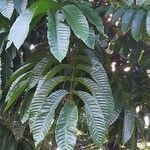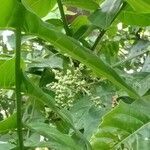Trees to 36 m; bole to 80 cm diam,., fluted; buttresses to 2.5 m tall, 3.5 m out, concave, plank-like. Bark grey-brown, smooth to scaling, lenticellate to densely pustular; inner bark creamish, flecked orange; sapwood creamish. Crown rather irregular, of massive branches and twigs with large terminal rosettes of leaves; twigs conspicuously cicatrose, cicatrices to 1 cm, scutellar; leafy twigs to 2 cm diam., ± lenticellate with wide pith sometimes inhabited by ants. Apical buds with fist-shaped young leaves. Leaves 30–125 cm, imparipinnate, up to 14-jugate, the distal leaflets developing some time after the more proximal, drying yellowish; petiole 3–8 cm, 3–5 mm diam., terete to flattened adaxially, glabrescent to softly pubescent, base swollen; rachis 4–5 mm diam., glabrescent to ± pubescent. Leaflets opposite to subopposite, the subterminal the largest, to 30 by 10 cm, the apical and most distal sometimes falling before developing, the more proximal smaller and even substipuloid in form, oblong-ovate, glabrous or weakly pubescent on midrib adaxially, glabrescent to softly pubescent or even tomentose abaxially, base strongly asymmetric obtuse to subcordate distally, acute to cuneate proximally, joining midrib up to 1 cm distal to junction of obtuse side and midrib, apex acuminate, nerves c. 10–12 on one side, 8–10 on other, prominent on both surfaces in sicco, arcuate, not linked at margin; petiolules 0–3 mm. Thyrses to 70 cm, axillary to supra-axillary, pendent, 1–2-branched, the primary to 20 cm, the more distal shorter, the secondary to 1.5 cm bearing fascicles of sessile flowers; bracts c. 3 mm long, long-triangular, pubescent. Flowers white to creamy yellow, somewhat foetid (Lasianthus-like, Mabberley); bracteoles c. 5, imbricate, orbicular, grading imperceptibly into sepals. Sepals 5, 2 mm long, adpressed pubescent, abaxially concave at base, margin ciliate; calyx cupular, c. 2.5 mm long and diam. Petals (4 or) 5, c. 12–14 by 2.5–3 mm, linear-lanceolate, valvate, sometimes weakly imbricate at apices, adpressed pubescent without, glabrous within, adnate to staminal tube in proximal half. Staminal tube ± sericeous on both sides, margin with 10 ± bifid lobes; anthers (9 or) 10(–15), c. 1 mm long, narrowly oblong, locellate, glabrous, attached in notches between lobes, ± protruding from tube, subsessile. Disk c. 2.5 mm long, cylindrical, subglabrous to adpressed pubescent especially within, margin ± 5-lobed to irregularly crenate. Ovary densely long-sericeous, 5-locular, each locule 2-ovulate; style terete, long sericeous in lower 3/4; stylehead short-cylindrical to subdiscoid. Fruit c. 3 cm diam., flattened globose, 5-lobed, densely yellow-brown tomentose, cerebriform in sicco. Seeds up to 10, red (raphearil cum sarcotesta), c. 1 cm long, plano-convex, borne on white carpel walls. Seedlings with simple leaves.
More
Tree to 36 m high; bole to 80 cm diam.; buttresses to 2.5 m high, 3.5 m out; bark scaling or smooth. Leaves in spirals, fist-shaped in bud, 30–125 cm long, imparipinnate, to 14-jugate, with distal leaflets tardily expanding; petiole 3–8 cm long; leaflets oblong-ovate, 8–30 cm long, 1.5–10 cm wide (subterminal), strongly asymmetric at base, acuminate at apex, glabrous adaxially, glabrescent to softly hairy abaxially. Thyrses to 70 cm long, 1-or 2-branched, axillary to supra-axillary; flowers sessile, somewhat foetid; bracteoles c. 2 mm long. Sepals 5, free, 2 mm long, glabrous to weakly adpressed-pubescent. Petals usually 5, linear-lanceolate, c. 12–14 mm long, cream to yellowish green, adnate to staminal tube in proximal ⅓, adpressed-hairy outside. Staminal tube usually sericeous; margin with 10 bifid lobes; anthers usually 10. Disc c. 2.5 mm long. Ovary 5-locular; locules 2-ovulate. Capsule 5-lobed, flattened-globose, c. 3 cm diam., densely yellow-brown tomentose, foetid when ripe. Seeds up to 10, planoconvex, 1 cm long, orange-red (raphe-aril cum sarcotesta).



